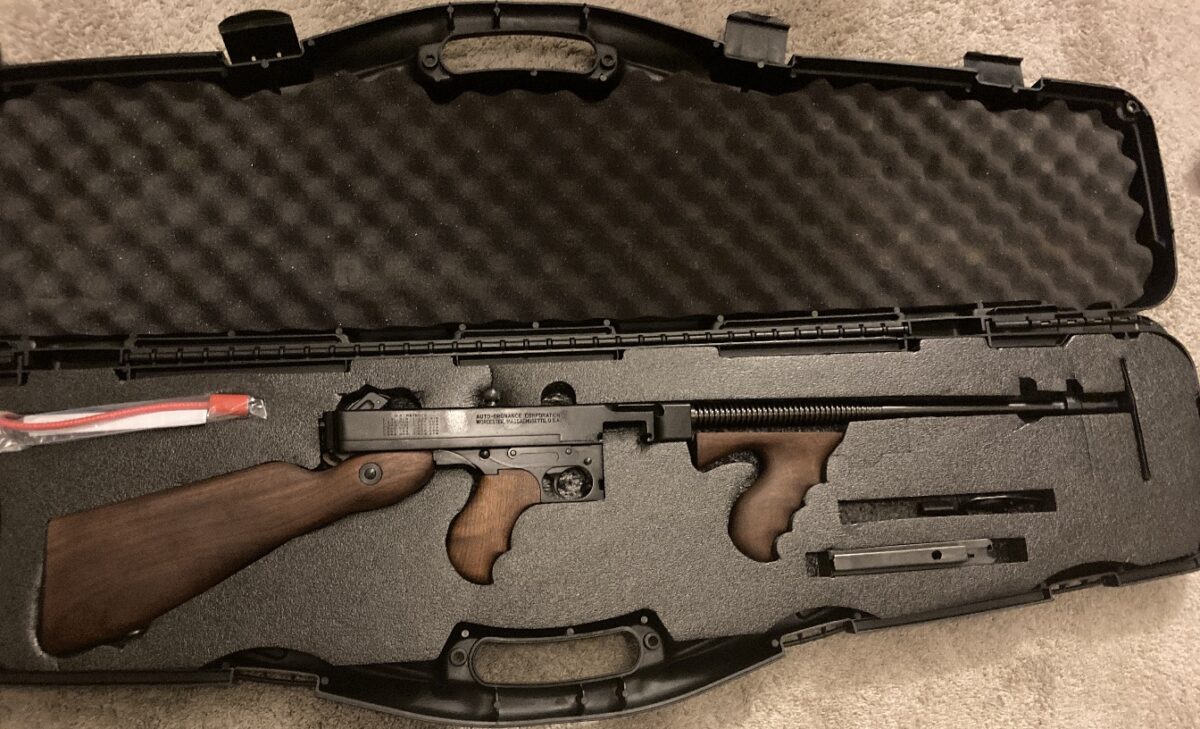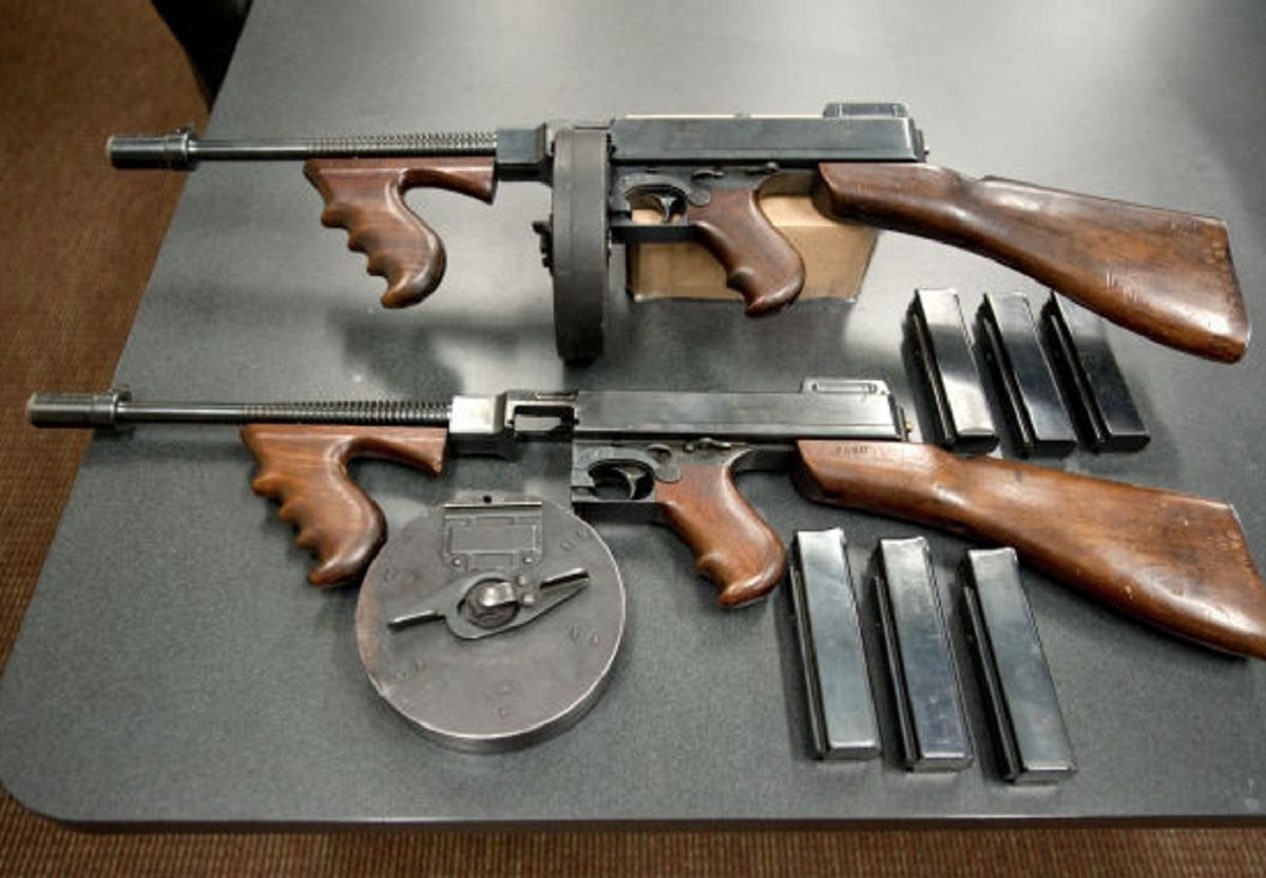“O-ver-RA-ted! … (clap-clap-clap-clap-clap) … O-ver-RA-ted! … (clap-clap-clap-clap-clap) …” Such is the traditional chant by American sports fans when their beloved hometown team pulls off a big upset victory against a much higher-ranked and supposedly far superior opponent. In the world of firearms, unfortunately, I could just as easily say the same thing about the adulthood experience of owning a firearm that had been a “dream gun” of mine back in my teenage years: the “Tommy Gun,” more specifically the M1927-A1 semiautomatic-only carbine version of the famous .45 caliber Thompson submachine gun (SMG).
Brief History
If you’ve seen your fair share of mobster movies, whether contemporaries such as the 1932 film Scarface (not to be confused with the F-bomb-laden 1983 remake starring Al Pacino) or later homages like 1987’s The Untouchables (the film for which the late great Sir Sean Connery won his Best Supporting Actor Oscar), you’ve seen the Tommy Gun. The Thompson SMG – the very first true SMG – was named for its inventor, U.S. Army Brig. Gen. John Taliaferro Thompson, who had intended the weapon for use in the First World War as a so-called ”trench broom.”
WWI ended before General Thompson’s invention could enter into service. Production models finally started up three years later, in 1921. The Thompson would eventually see frontline combat usage by the U.S. Armed Forces, and didn’t even have to wait ‘til WWII for this distinction; the Marine Corps used the firearm in Nicaragua during the so-called “Banana Wars” of in the late 1920s and early 1930s.
Alas, even though Tommy Guns were primarily used by the good guys, its usage by the bad guys in infamous incidents like the St. Valentine’s Day Massacre colored the gun’s reputation (hence the “Chicago Typewriter” sobriquet), which in turn led to the National Firearms Act (NFA) of 1934, which made it extremely difficult for private citizens to own a true full-auto Thompson SMG (or any other automatic firearm or machine gun). Luckily, Tommy Gun manufacturer, the Auto-Ordnance Corporation – acquired by Kahr Arms in 1999 – had the presence of mind to release the M1927, which, as the official company website states, “is simply the Model 1921 restricted to semi-auto fire. The action and magazines are the same as the Model 1921.”
Personal Shooting Impressions – Back Then
I first got to fire the M1927 as a 15-year-old kid back in April 1991 at the now-defunct Santa Anita Firing Range in Monrovia, Calif. I was hooked from the get-go! Though I was already a fan of the .45 ACP cartridge, at that point in my life I hadn’t yet mastered the M1911 pistol, so I became instantly enamored (strictly platonically speaking, of course) of .45 caliber weapon that had such recoil and enabled me to punch .45 caliber holes in my targets with such tack-driving accuracy.
Alas, there was a catch. Though the word “unobtanium” didn’t enter my vocabulary until the 2009 James Cameron film Avatar came out, the Tommy Gun was one of those guns – along with the Heckler & Koch (HK) P7 – that would’ve been easily classified as an unobtanium element of my teens and 20s, i.e. a highly desirable fun gun that was simply too damn expensive.
Personal Shooting Impressions – Nowadays
Fast-forward all the way to December 2017. By this time, I was 43 years old, and taking some hard-earned rest and relaxation as a damn dirty mercenary, er, privateer, er, private military contractor (PMC) at Balad Airbase, Iraq. The salary from that gig left some extra cash burning a hole in my pocket, and Glory Hallelujah, whadddya know, I was finally able to afford a Tommy Gun, so I bought an M1927-A1 from Pro-Tek Guns in Kilgore, Texas.
And then I took the gun to the range again and again over the course of the past 4.66 years. And the gun has let me down every time.
Sure, the accuracy is still there. Sure, the soft-shooting nature is still there. And the classic aesthetic beauty is still there.
The positives end there.
Whether using the factory-furnished 20-round stick magazine or the more cinematic-looking 50-round drum magazine for which I coughed up an extra 300 bucks subsequent to the initial gun purchase, I’d be lucky if I could coax even 10 straight jam-free rounds out of the beast. Typical malfunctions involve ejection failures, failures to go into battery, and the bolt locking open prematurely. Granted, a fair number of semiauto firearms – especially older designs – require a break-in period of 500 rounds or so before they start functioning smoothly and reliably.

Tommy Gun author used at the range. Image Credit: 19FortyFive.
Well, after this past weekend’s visit to the excellent Silver Eagle Group (SEG) indoor shooting range facility in Ashburn, Virginia, using a 50-round box of PMC Bronze 230-grain FMJ ammo, my round count is easily past 750 rounds. But the reliability hasn’t gotten any better. To make matters worse, the damned rear sight assembly sheared clean off the weapon’s receiver! Fortunately, the charging handle on the M1927 is also atop the receiver and has a notch which enabled me to use as an improvised rear sight; this enabled me to keep all my shots in the 5-zone for 7-yard head shots and 15-yard torso shots, but only a 50-percent hit rate on the noggin and body alike at 25 yards.
To make matters worse, the spring tension on the charging handle is excessive! Mind you, I weigh 200 lbs. of mostly muscle, I work out regularly, and can chest-press 230 lbs. on a good day … yet every time I work the bolt, whether to chamber a round or to clear yet another jam, I feel like I’m gonna strain my bicep and/or pull my shoulder out of its socket. I don’t recall having these issues with the Tommies I fired during my younger, skinnier days, so maybe the manufacturer goofed by setting the spring tension too high, and that in turn is the cause of the reliability issues. The manufacturer’s 1-year warranty is obviously long expired, so maybe a trip to my local gunsmith is in order.
Meh. What a letdown.
Christian D. Orr has 33 years of shooting experience, starting at the tender age of 14. His marksmanship accomplishments include: the Air Force Small Arms Ribbon w/one device (for M16A2 rifle and M9 pistol); Pistol Expert Ratings from U.S. Customs & Border Protection (CBP), Immigration & Customs Enforcement (ICE), and the Federal Law Enforcement Training Center (FLETC) Criminal Investigator Training Program (CITP); multiple medals and trophies via the Glock Sport Shooting Foundation (GSSF) and the Nevada Police & Fires Games (NPAF). Chris has been an NRA Certified Basic Pistol Instructor since 2011. In his spare time, he enjoys (besides shooting, obviously) dining out, cigars, Irish and British pubs, travel, USC Trojans college football, and Washington DC professional sports.

